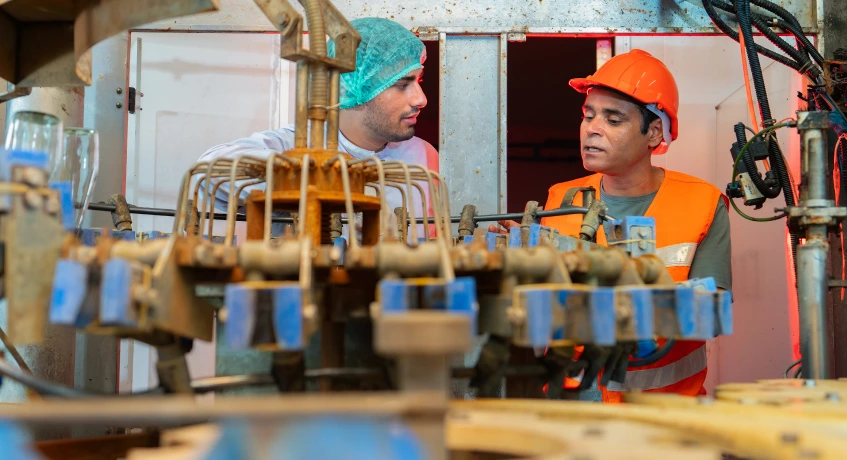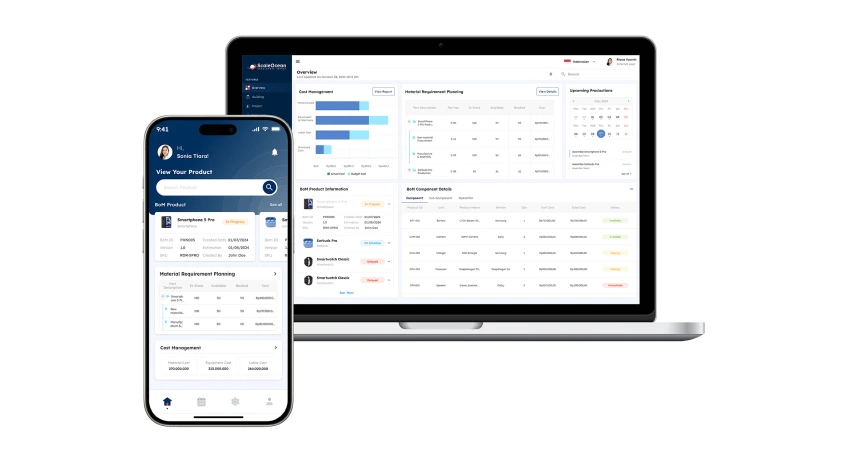Successful manufacturers consistently surpass their competitors by improving production efficiency, which refers to the ability to maximize output while minimizing waste, time, and costs. Singapore’s manufacturing sector is recognized for its innovation and high-quality standards. To stay competitive, businesses need to improve efficiency to boost productivity and cut operational costs. In December 2024, Singapore’s manufacturing output increased by 10.6% year-on-year. For the full year of 2024, output was 4.3% higher compared to 2023.
Efficient manufacturing processes not only increase profits, but also ensure long-term growth. But what exactly is production efficiency, and how can businesses measure it effectively? Understanding its key components and the factors that influence it is essential for companies striving to refine their operations. In this article, we’ll explore what production efficiency means, how to calculate it, and the critical elements that impact overall performance.

Understanding Production Efficiency
Production efficiency refers to a company’s ability to maximize output while minimizing input, ensuring that resources are used optimally without compromising quality. Businesses can boost their productivity and operational effectiveness by streamlining processes, reducing waste, and leveraging technology.
Achieving high production efficiency leads to cost savings, increased profitability, and competitiveness. Adjusting takt time to match production demand helps businesses meet market needs faster, improve customer satisfaction, and adapt to trends, driving long-term growth in today’s fast-paced market.
Key Factors Influencing Production Efficiency

Production efficiency is influenced by several critical factors that work together to optimize operations. These include resource utilization, process optimization, technology integration, and labor management, all of which contribute significantly to increased productivity and cost reduction.
1. Resource Utilization
Effective management of materials, labor, and machinery ensures minimal waste and downtime. Companies that optimize resource allocation and track cycle time can avoid inefficient spending, maintain output, and boost operational efficiency, especially in mass manufacturing sectors where meeting high demand is crucial.
2. Process Optimization
Streamlining production processes eliminates bottlenecks and reduces cycle times. This includes analyzing workflows, identifying inefficiencies, and implementing improvements to ensure smoother and faster production cycles. Standardizing procedures and incorporating lean manufacturing principles, such as effective WIP management, can help to increase speed, reduce defects, and improve overall process reliability.
3. Technology Integration
Implementing advanced technologies such as automation, IoT, and data analytics improves production capacity. These tools enable real-time monitoring, predictive maintenance, and data-driven decision-making, resulting in increased efficiency and lower operating costs. Businesses that use smart technologies can address potential issues before they escalate, ensuring uninterrupted operations.
4. Workforce Management
Skilled and motivated employees are essential for maintaining high production efficiency. Proper training, clear communication, and performance incentives ensure that the workforce operates at peak productivity, contributing to overall operational success.
Encouraging collaboration and offering continuous upskilling opportunities, employees adapt to technological advancements and evolving industry demands. A flexible build-to-order system also supports this by allowing customized workflows to align with employee skills and job roles.
5. Measuring Production Efficiency
Businesses must monitor and analyze key metrics to improve production efficiency. Accurate measurement enables data-driven decisions, process optimization, and inefficiency reduction. Benchmarking against industry standards assists in setting realistic goals. Regular audits increase efficiency by revealing gaps. These strategies ensure that manufacturing operations experience long-term growth and competitiveness, particularly in mass production.
6. Performance Metrics
Key performance indicators (KPIs) like Overall Equipment Effectiveness (OEE) measure productivity, availability, and quality. Production yield tracks output consistency, while cycle time gauges speed. So, a list of bill materials is essential for tracking resource usage, optimizing production, and improving efficiency.
7. Benchmarking
Benchmarking compares a company’s performance to industry standards or competitors. It identifies inefficiencies, operational weaknesses, and areas for improvement. Businesses can set attainable performance goals by analyzing best practices. Regular benchmarking encourages innovation and process optimization. This practice ensures that businesses remain competitive while continuously improving their production efficiency.
8. Regular Audits
Audits evaluate production efficiency by detecting bottlenecks, wasteful spending, and compliance issues. They aid in the optimization of workflows, increasing equipment usage, and lowering operational expenses. Regular reviews foster continuous process improvement. Audits also guarantee that the requirements of efficiency are met. Businesses gain from increased productivity, better resource allocation, and higher profitability.
Calculating Production Efficiency
Production efficiency is calculated to determine how effectively a company is utilizing its resources to achieve desired output levels. The formula for production efficiency is:
Production Efficiency = (Actual Output / Standard Output) × 100
Explanation:
– Actual Output: The number of units actually produced within a specific time frame.
– Standard Output: The maximum number of units that can be produced under ideal conditions, based on the production line’s capacity or design.
Example:
If a production line is designed to produce 300 units per day (standard output) but only manages to produce 180 units (actual output), the production efficiency is calculated as:
(180 / 300) × 100 = 60%
This means the production line is operating at 60% efficiency, indicating room for improvement in resource utilization, process optimization, or technology integration to achieve higher output levels. Regularly calculating production efficiency helps businesses identify inefficiencies and implement targeted strategies for improvement.
Strategies to Improve Production Efficiency
Improving production efficiency necessitates a comprehensive strategy that prioritizes process optimization, personnel empowerment, and equipment maintenance. Process standardization, employee training, and preventive maintenance are all important measures for improving operations and production.
1. Process Standardization
Developing standardized procedures ensures that every production step follows a consistent approach, reducing deviations and errors. Clear workflows help employees understand their roles, streamline tasks, and optimize resource utilization. Standardization also enhances product quality by minimizing variations, ensuring compliance with good manufacturing practices, and supporting scalability as the business grows.
2. Employee Training
Employees receive ongoing training to operate machinery safely and efficiently. This includes knowledge of material requirement planning (MRP), which ensures the right materials are available when needed. A trained team responds quickly to process changes, boosts productivity, and fosters improvement.
3. Preventive Maintenance
Regular maintenance schedules help detect potential issues before they lead to costly breakdowns, ensuring smooth production. Preventive maintenance includes routine inspections, part replacements, and system upgrades to optimize equipment performance. By minimizing unplanned downtime and extending machinery lifespan, businesses can maintain high operational efficiency and reduce repair costs.
4. Technology Adoption
Integrating technologies such as automation, IoT, and AI-driven analytics enhances production efficiency and decision-making. Real-time monitoring helps detect anomalies, predictive maintenance prevents unexpected failures, and data-driven insights improve resource allocation.
Embracing digital transformation, including the best manufacturing execution system, helps businesses optimize workflows, reduce waste, and stay competitive. Utilizing a work-in-progress indicator ensures better tracking of production stages, improving overall efficiency in a fast-evolving market.

Leveraging Technology to Improve Efficiency
Technology enhances production efficiency through automation, data analytics, and IoT integration, improving accuracy and decision-making. To sustain these gains, businesses must measure performance, benchmark standards, and conduct regular audits.
1. Automation Solutions
Implementing automation streamlines repetitive tasks, improving efficiency and accuracy while minimizing human error. Automated systems enhance consistency in the product lifecycle, reducing delays and waste. By handling routine operations, automation frees employees for strategic tasks. This shift boosts innovation and problem-solving capabilities. Ultimately, automation drives productivity, cost savings, and operational excellence in manufacturing.
2. Data Analytics
Data analytics enables businesses to acquire greater insights into production performance. Analyzing real-time information allows you to identify inefficiencies and bottlenecks. Predictive analytics promotes proactive decision-making, waste reduction, and resource optimization.
Businesses can enhance workflows by spotting new trends. Data-driven techniques enable continual improvement, increased productivity, and a competitive edge in manufacturing. Understanding the importance of a manufacturing process plan ensures that these improvements align with business goals.
3. IoT Integration
IoT devices connect machines, sensors, and systems, enabling seamless data collection and monitoring. Real-time tracking improves equipment reliability and enhances predictive maintenance. IoT minimizes downtime by detecting faults before failures occur. Integrating IoT optimizes energy usage and resource allocation. This connectivity fosters smarter operations, increased efficiency, and long-term sustainability in manufacturing.
ScaleOcean’s Manufacturing Software for Streamlined Production

ScaleOcean offers comprehensive manufacturing software solutions designed to enhance production efficiency. By streamlining processes and minimizing inefficiencies, ScaleOcean helps manufacturers lower their Cost to Company (CTC), ensuring better resource allocation and higher profitability. Whether you’re a small business or an enterprise, our software adapts to your needs, ensuring seamless operations and sustainable growth. Experience the future of manufacturing with ScaleOcean book a free demo to see how it can transform your production processes.
Key Features
- Real-Time Monitoring: Track production metrics in real time to identify inefficiencies and make data-driven adjustments for continuous improvement.
- Process Automation: Automate routine tasks to streamline operations, reduce manual errors, and allocate resources more efficiently.
- Data Analytics: Leverage in-depth analytics to gain actionable insights from production data, helping you make informed strategic decisions.
By implementing ScaleOcean’s manufacturing software, businesses can achieve significant operational advantages. One of the key advantages is cost savings, as the system reduces waste, optimizes resource allocation, and lowers operational costs. Manufacturers can also improve product quality by standardizing procedures and automating quality control methods, which reduces faults and increases customer satisfaction. Furthermore, ScaleOcean’s software is designed for scalability, allowing businesses to easily grow production in response to market demand without sacrificing efficiency or quality.
Conclusion
Enhancing production efficiency enables businesses to increase profits, reduce operational costs, and maintain a strong competitive edge. By streamlining workflows, minimizing waste, and optimizing resource utilization, companies can achieve greater output with fewer disruptions. Implementing automation and leveraging data-driven strategies improve accuracy, speed, and decision-making, ultimately leading to higher productivity.
In today’s rapidly evolving market, staying ahead requires continuous innovation and adopting the latest technologies to drive efficiency and long-term success. Explore how ScaleOcean manufacturing software can be the catalyst for transforming your production processes and driving business success. With real-time monitoring, predictive analytics, and seamless integration, ScaleOcean empowers manufacturers to make smarter decisions and improve overall efficiency. Don’t let inefficiencies hold your business back, embrace innovation and take your manufacturing operations to the next level.








 PTE LTD..png)
.png)

.png)








.png)
.png)
















